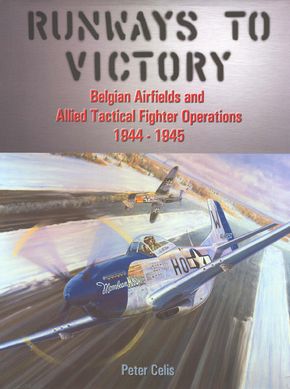MARHAV | Runways To Victory: Belgian Airfields and Allied Tactical Fighter Operations 1944-1945
Reviewed by Mark Proulx

MARHAV
Runways To Victory
Belgian Airfields and Allied Tactical
Fighter Operations 1944-1945
Hard Cover
8 ½ x 11 ½
362 Pages
ISBN 90-805-6392-7
This is a review of the recently released book, Runways to Victory. The book is written by Peter Celis, a Belgian fighter pilot flying F-16s with the 31st Fighter Squadron from Kleine-Brogel Air Base. Published by MARHAV in Luxembourg, the quality is excellent. The extensive text and photos are printed over thick, quality bond paper covering 362 pages.
S/L Art Sager, DFC, wrote the forward. He flew with 421 and 416 RCAF Squadrons in 1943-44 as a Flight Commander. He would then provide leadership to 443 RCAF Squadron as Commanding Officer. Sager would be credited with 4 and 2 shared aerial victories, 1 "Probable", 5 and 1 shared "Damaged".
Runways to Victory begin by detailing the achievement of Air Supremacy immediately before and after Operation Overlord. Thousands of tactical aircraft were deployed to Europe to assist the Liberation Armies with badly needed close air support. Units would be supplied from the US with groups from the Ninth Air Forces. Commonwealth countries would send aircraft from the British 2nd Tactical Air Force. This massive build up of forces would require hundreds of repaired and newly manufactured airfields.
The author goes into extensive detail describing how airfields in Belgium were repaired and constructed. Maps and photos, many of them from high altitude, detail the layout of many of the airfields. Of the hundreds of airfields, Peter has chosen to detail operations at seven Belgian airfields. They are:
- A-78 Florennes
- A-84 Chievres
- A-92 St. Trond
- Y-10 Le Culot/East
- Y-29 Asch
- B-67 Ursel
- B-90 Petit Brogel
The book is illustrated with a large number of photographs, the overwhelming majority having never been seen before. What makes this book such a pleasure is the sheer number of different aircraft types that are depicted. Extensive photos of such aircraft as the P-61 Black Widow, P-51 Mustang, P-47 Thunderbolt, Hawker Typhoon and Supermarine Spitfire, just to name a few, are all included. Some of these photos are reproduced in color. To satisfy those with an interest in German aircraft, some photos are included of aircraft that were left behind by the retreating forces.
A complete reference guide to Belgian airfields is included. Here, the author details each base of operations. Peter supplies such information as origins of the airfield, location and its history from before the war to the end of hostilities and beyond. He also provides information about specific aircraft flown from the base, their assignment and duration of their operations.
There are a number of Appendix's attached listing such items as each numbered allied airfield in Europe, listings of Aces who operated from Belgium, losses and statistics. All references used are identified, and the list is long. The operations conducted by the Eighth Air Force frequently overshadowed those of the Ninth and 2nd TAF units that were sent to Europe. However, their role was no less important. Some will argue that tactical forces played a more vital role. It is quite evident, given the volume of research material, that this undertaking took some time to complete and is a labor of love for the author. To those having an interest in WW II aviation history, I strongly recommend that you add this book to your reference library. I'm confident that you will not be disappointed.
© Mark Proulx 2003
This review was published on Saturday, July 02 2011; Last modified on Wednesday, May 18 2016
